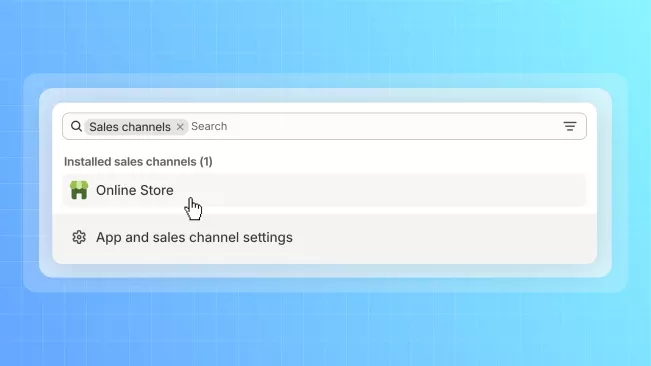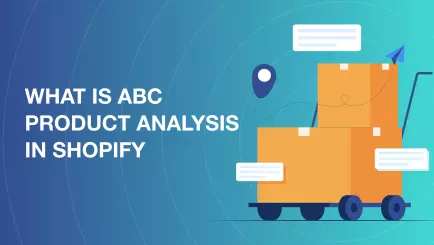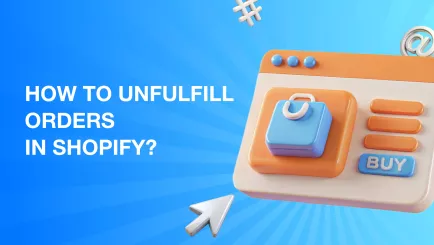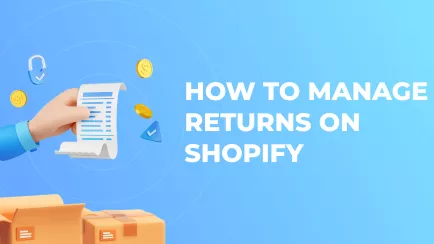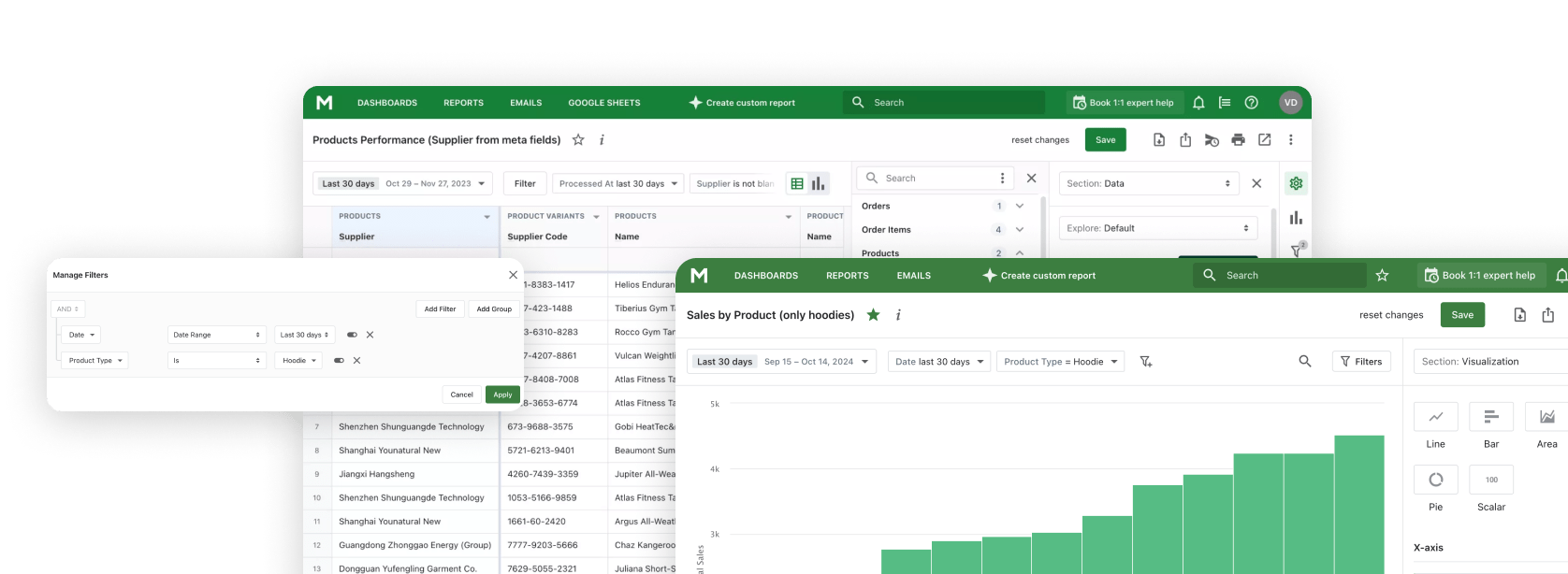Using multiple sales channels is a popular and effective way to expand commerce. Different sales channels may reach different audiences, thus increasing customer flow. However, there are nuances and questions. What Shopify sales channels exist? Are there certain channels that are more profitable? Today, we will answer these questions and more, so let’s dive in!
Shopify Reports provide insights into the performance of various sales channels, helping you identify which platforms generate the highest revenue and engagement for your store.
What is a sales channel on Shopify?
So, what are Shopify sales channels? They are places where you distribute your products. For example, your Shopify store is a sales channel because you sell items there. Connecting your store to the Facebook shop will also create a new channel. Certain Shopify sales channel APIs are built into the store, while others must be connected through third-party apps.
The importance of sales channels in Shopify
Having multiple Shopify shop channels is almost always good for your commerce. Small stores may not need them, but large traders rely on them to attract customers and expand to new markets. Here are the main benefits that new channels bring:
- Audience diversity. When you add a sales channel on Shopify, you interact with people unique to this market. For example, some customers prefer Facebook as an online shopping platform. A new sales channel can attract them to your goods.
- Ease of access. Every new Shopify sales channel promotes your products to different audiences. However, different people prefer different shopping methods. Promote your items at several markets and provide different buying methods, and you will attract more customers.
Of course, every store doesn’t need to use a Shopify sales channel API. But without it, you won’t reach your business’s maximum potential.
Explore related reports
What are the sales channels on Shopify?
There are many supported shop sales channels in Shopify. Most are supported out of the box, while some may need additional preparations or apps to work properly. We will review all the types and discuss their pros, cons, and nuances.
Your shops
This sales channel on Shopify is available right from the start. Your shop is your first channel and one of the most flexible ones. That is the main pro of it – Shopify stores are highly customizable with themes, layouts, and apps. You can also create multiple storefronts for different types of shops.
However, the main con to any Shopify store is its promotion. Most shops completely rely on external promotions like ads, partnerships, etc. Unlike social media, which has a natural visitor flow and free promotional means for everyone, the Shopify store won't attract customers out of nowhere.
Marketplaces
One of the most popular Shopify channels is marketplaces like Amazon or Etsy. The main pros of these channels are ease of integration and the market's popularity. Amazon has built-in integration. Marketplaces like Etsy and eBay can be easily connected via apps. They also have a large and active audience.
The main con of these shopping channels is high competition. Chances are that someone is already selling items you sell on Amazon and has many loyal customers. Be prepared to compete directly with other merchants.
Social media
Social media integration has become almost necessary in the past decade. Shopify has built-in integration for Meta (Facebook and Instagram) and YouTube. Other platforms, like Pinterest and TikTok, can be connected through apps.
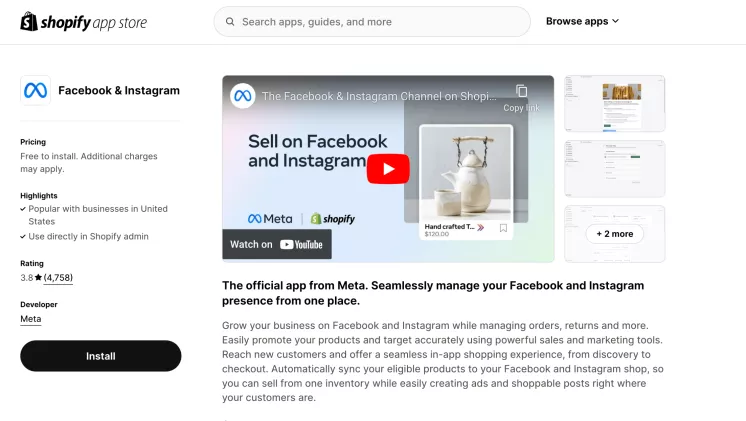
The main pros of social media are natural traffic and a wide audience. With the right content and starting promotion, your items can "go viral" and promote themselves to a large audience.
The main cons are inconsistency and needed effort. One day, your items can be all the rage on socials, but trends will move on, and sales will drop. Also, if you want real traction, you must create unique and fun content. Simple ads won’t bring you many sales on social media.
Buy buttons
You can add a sales channel in Shopify in the form of a buy button to any internal or external platform. For example, you can put a buy button in your blog posts or social media. Clicking on the button will let users buy your showcased products while staying on the current page.
The main pro of a buy button is its flexible placement. For instance, you can place it under the article about your products to entice readers to buy something. The button is quick and easy to use, making the experience smooth.
The main con, however, is its limited power. Shopify buy buttons typically let users purchase only one item at a time without visiting your shop. This kind of limited targeting rarely yields loyal customers.
Wholesale
The wholesale Shopify shop channel allows you to sell products to retailers for distribution. Essentially, it's a B2B business model. You can set up separate storefronts for retailers, create blended or dedicated stores, and manage catalogs and rules. Sales channel API on Shopify supports wholesale channels without additional apps.
The main pros of this channel are wider reach and lower operational costs. Big established retailers already have their audience, and often a large one. Several small retailers can reach different markets and invite more customers. Also, your potential partners will often have their marketing, logistics, etc, so you won’t have to worry about it.
The main cons are lower profits and lower control. You will sell your products in bulk for a lower price, reducing the profit margin. You will also have less control over the sales process. Advertisements, discounts, distribution – the retailer often decides what is best for sales.
Shop app
You can connect your store to the Shopify sales channel app called Shop. It is used for package tracking, browsing stores, and buying items via Shop Pay checkout.
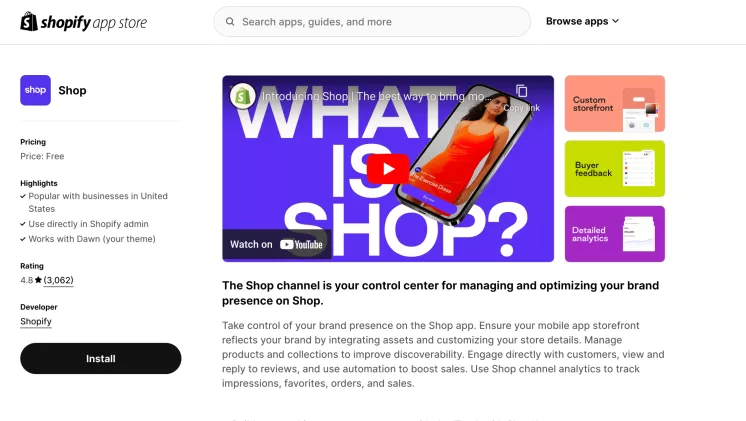
Pros of this channel are its simplicity of setup and free reach. You can connect and customize your store in the app in mere minutes, and your inventory will be automatically listed and displayed. The app gives you additional promotion and reach without hefty investments. Given the ease of usage and potential benefits, it doesn’t have real cons.
Online search
Shopify API for sales channels allows you to integrate with Google Search, Shopping, and Images. Your products will be shown directly on the search pages for users to see and buy.
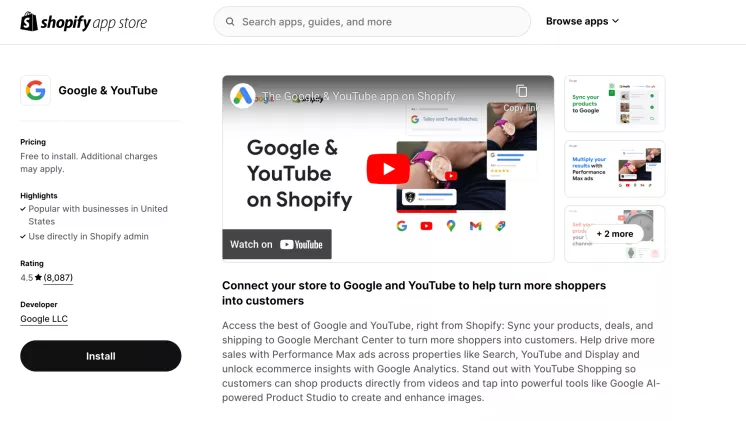
This sales channel has negligible cons and some big pros. It is free to use but offers more than just advertisement and sales. You can create campaigns, access insights, conduct customer analysis, and more. Google’s services also have some of the biggest reach on the Internet.
POS
Shopify's point-of-sale system lets you connect your online store with in-person shops. Thus, your real-life store becomes a sales channel in your Shopify account.
The main pros are the unique reach and ease of installment. Some people don't shop online or at least do it infrequently and laboriously. Only physical stores can attract this kind of clientele. Creating a POS is also as simple as possible. You just need basic equipment, even a phone will do, and Shopify software.
The main con is investments. Opening a physical Shopify spot will be an investment, even for a short event. You will need staff, equipment, and a place.
Collabs
Shopify allows different businesses to collaborate for profits. You can cross-sell your stock through other merchants or team up with influencers. Shopify provides special apps for this purpose.
The main pros of collaborations are the borrowed reach and loyal customers. Merchants and influencers have an audience you can use to advertise your goods.
The main con, however, is inconsistency. Collaborations might yield additional revenue or nothing at all. After all, there is no guarantee that your partner's audience will like your products. But you still must uphold the terms of the deal, even with zero profits.
Best sales channels for Shopify
So, from this long list, what are the best sales channels for Shopify? Firstly, the obvious – your store is among the best Shopify sales channels. It's the most flexible and reliable platform you can get. Secondly, let’s discuss other, less obvious answers.
Google integrations
According to the Search Engine Land, 31% of searches for products start at Google. An average Google ad has a conversion rate of 2%. It seems not that much. But if you consider that relevant traffic is measured in millions – it becomes a different story. And that is only a direct search for items. Nowadays, Google can also show your products in Images and Lens.
Google integrations are also among the best shopping channels because of their accessibility. Shopify provides a free means to feature your products in Google Shopping. You can create campaigns, access analytics, and even use AI for customer research. Moreover, once set up, you can let automation do most of the work. Google was and still is one of the most profitable sales channels.
Modern social media
The culture of buying stuff through social media shops rose significantly during COVID. More and more people purchase based on influencers' opinions and clever, funny ads. The millennial generation checks socials before buying something from the store. Generation Z trusts TikTok more than traditional stores as a shopping platform. The audience of social media also is on the rise.
Selling through social media may be more challenging than selling through Google Shopping or Amazon. You must connect to the audience and give them more than ads and a store. However, if done correctly, you can receive a significant boost in revenue, especially if you get viral fame.
Traditional marketplaces
During COVID, Amazon became the most popular and trusted platform among US customers. More than half of Amazon's sales come from independent merchants who use the platform as a sales channel. Etsy also received an increase in traffic in the 2020s, reaching 700 million in a month.
Traditional marketplaces have fees and quite a lot of wild competition. However, they also give merchants a wide, pre-established audience that trusts the marketplace. This trade-off is worth it, given the annual billions of unique visitors across platforms.
Wholesale and retail
The two sides of one coin. The retail and wholesale ecosystem is slowly but steadily growing while dropshipping and reselling are losing popularity. Some businesses make wholesale their only channel, creating "omnistores". Others work as retailers, buying stock in bulk from different merchants instead of manufacturers.
Both strategies are popular and profitable, but they pose a double-edged sword. Wholesale allows you to move large inventories and don’t worry about marketing and individual distribution. However, it takes away a lot of control. On the other hand, retail gives more control over the cost of investments and overheads.
Conclusion
Shopify supports many sales channels, but they all have pros and cons. The best sales channels on Shopify are Google integrations, social media, marketplaces like Amazon and Etsy, and wholesale channels. They provide many active customers and advertising, hence higher potential revenue. Most are also easy to set up and don’t require much investment.
Shopify Sales Reports can help you evaluate the performance of each sales channel, providing detailed data on revenue and customer engagement to determine which channels are most effective for your business.
Frequently asked questions about Shopify sales channels
What are the sales channels on Shopify?
Sales channels are platforms where you sell your items. Your Shopify store is a sales platform, as is a Google Shopping listing, buy button in a blog post, Facebook store, etc.
Why do stores add multiple sales channels on Shopify?
Different sales channels provide access to different audiences. Not all Facebook users also shop on Amazon or click buy buttons. Employing several Shopify sales channels increases your reach and allows you to attract more diverse customers.
Can I use multiple sales channels at the same time?
Yes, you can use several channels at the same time. Most Shopify sales channels you can connect are not mutually exclusive to each other. Some collaborations with other shops and influencers can be exclusive through contracts, but it's an exception rather than a rule.
What are digital sales channels on Shopify?
Digital sales channels include traditional marketplaces, mobile apps, and social media. Examples include Amazon, Etsy, Facebook, the Shop app, and buy buttons. Most Shopify channels are digital by nature.
How to add a sales channel on Shopify?
The basic process is simple:
- Open your Shopify admin panel.
- Navigate to "Settings" and then to "Apps and sales channels".
- On the opened page, click "Visit the Shopify App Store".
- Choose channels you like and click the "Add channel" button.
However, a more detailed process can differ for different Shopify sales channels. If necessary, search for detailed instructions for a specific channel.
